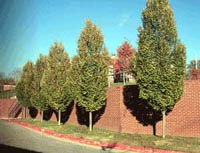Resource Library
Plant of the Week: Hornbean, Fastigiate European
The University of Arkansas System Division of Agriculture does not promote, support or recommend plants featured in "Plant of the Week." Please consult your local Extension office for plants suitable for your region.
Plant of the Week
Fastigiate European Hornbean
Latin: Carpinus betulus

Egg-shaped trees have a place in the modern landscape as testified by the much overused
and now maligned Bradford pear. It went from the most popular tree in 1990 to being
stricken from the roster of nurseries a decade later.
The new kid on the block in the Egg and Us arena is the Fastigiate European Hornbeam. Hopefully this fine tree will be used
with more moderation than the omnipresent ornamental pear.
The European Hornbeam is an oval shaped tree that grows to 40 feet tall and 15 to
20 feet wide with a plethora of relatively small but strong branches. The leaves are
two inches long and under an inch wide with fine teeth running the length of the blade.
The fall color is yellow-brown. The tree has no significant flowers.
This tree is the European cousin of our native Carpinus caroliniana (Ironwood, Blue Beech or American Hornbeam) which is common through the mountainous
regions of the state.
Few European trees have been widely used in the American landscape because the number
of trees to choose from is relatively small. Europe’s miserly list of trees is because
of the arrangement of the continent’s mountains - they run east and west. When the
glaciers came, only the toughest plants were able to survive the climate change and
unrelenting push of the ice sheets. In the Americas the mountains run north and south
and plants were able to migrate in front of the ice sheets and migrate back as conditions
improved.
The Fastigiate European Hornbeam was introduced into the US in 1883 but has never
been extensively grown. I suspect its modern day renaissance has to do with an attempt
to find a substitute for the Bradford pear now that we have become hooked on the egg
shaped aesthetic. But unlike the tree it is replacing, the Hornbeam is a tough-wooded
tree that will not likely suffer the breakage associated with the ornamental pear.
Hornbeam wood was never a wood of much consequence to the commercial forester because
the tree trunks never attained saw-log status. It is incredibly tough and has been
used for cogs, tool handles and for making wooden bowls and dishes. To the landscaper
this tough-wooded characteristic means that the tree will not split apart in ice or
wind storms like other twiggy kinds of egg-shaped trees. Hopefully the landscape designers
of tomorrow will be more restrained in their use of this fine tree.
The European Hornbeam is an adaptable tree doing well in full sun or medium shade.
It tolerates a wide array of soil conditions but performs best where it can get some
summertime moisture. I have the straight species growing in my shaded woodland garden
and have found the tree to do exceedingly well even competing with a full stand of
oaks.
The Hornbeam takes on a beautiful soft yellow brown fall color late in the season
and gives a dignified end to the fall season. The Hornbeams are not prone to insect
or disease attack. Seeds, while they may be produced on old trees, are difficult to
germinate and will not present a problem with escapes.
By: Gerald Klingaman, retired
Extension Horticulturist - Ornamentals
Extension News - November 10, 2000
The University of Arkansas System Division of Agriculture does not maintain lists of retail outlets where these plants can be purchased. Please check your local nursery or other retail outlets to ask about the availability of these plants for your growing area.